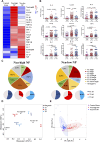Characterizing the Neutrophilic Inflammation in Chronic Rhinosinusitis With Nasal Polyps
- PMID: 34977034
- PMCID: PMC8718617
- DOI: 10.3389/fcell.2021.793073
Characterizing the Neutrophilic Inflammation in Chronic Rhinosinusitis With Nasal Polyps
Erratum in
-
Corrigendum: Characterizing the neutrophilic inflammation in chronic rhinosinusitis with nasal polyps.Front Cell Dev Biol. 2024 Jul 18;12:1450040. doi: 10.3389/fcell.2024.1450040. eCollection 2024. Front Cell Dev Biol. 2024. PMID: 39092187 Free PMC article.
Abstract
The mechanisms underlying neutrophilic inflammation in chronic rhinosinusitis with nasal polyps (CRSwNP) remain poorly investigated. This study aimed to examine the factors that contribute to tissue neutrophilia in CRSwNP. The numbers of neutrophils and active caspase-3-positive apoptotic neutrophils in sinonasal tissues were assessed via immunofluorescence staining. The 95th percentile of tissue neutrophil numbers in control subjects was selected as a cut-off to define neutrophil-high (Neu-high) or neutrophil-low (Neu-low) nasal polyps (NPs). The levels of 34 inflammatory mediators in sinonasal tissues were analyzed using Bio-Plex assay. Purified human peripheral blood neutrophils were incubated with nasal tissue homogenates, and the apoptotic neutrophils were assessed via flow cytometry. The cut-off for Neu-high NPs was >10 myeloperoxidase positive cells/high-power field. Compared with Neu-low NPs, Neu-high NPs had higher tissue levels of IL-1β, IL-1Ra, IL-6, IL-8, G-CSF, MCP-1, and MIP-1α, but lower levels of IL-5, IL-13, IgE, and eosinophils. Principal component and multiple correspondence analyses revealed mixed type 1, type 2, and type 3 endotypes for Neu-low NPs, and predominant type 1 and type 3 endotypes for Neu-high NPs. Neu-high NPs had lower percentages of apoptotic neutrophils than Neu-low NPs. The numbers of neutrophils and the percentages of apoptotic neutrophils correlated with G-CSF and IL-6 levels in the NPs. Tissue homogenates from Neu-high NPs, but not those from Neu-low NPs, suppressed neutrophil apoptosis in vitro, which was reversed by anti-G-CSF treatment. Tissue neutrophil numbers were associated with difficult-to-treat disease in patients with CRSwNP after surgery. We propose that G-CSF promotes neutrophilic inflammation by inhibiting neutrophil apoptosis in CRSwNP.
Keywords: apoptosis; chronic rhinosinusitis with nasal polyps; granulocyte colonystimulating factor; inflammation; neutrophil.
Copyright © 2021 Ruan, Zhao, Li, Liao, Pan, Zhu, Feng, Liu, Yu, Song, Wang and Liu.
Conflict of interest statement
The authors declare that the research was conducted in the absence of any commercial or financial relationships that could be construed as a potential conflict of interest.
Figures







References
-
- Bachert C., Zhang N., Holtappels G., De Lobel L., van Cauwenberge P., Liu S., et al. (2010). Presence of IL-5 Protein and IgE Antibodies to Staphylococcal Enterotoxins in Nasal Polyps Is Associated with Comorbid Asthma. J. Allergy Clin. Immunol. 126 (5), 962–968. 10.1016/j.jaci.2010.07.007 - DOI - PubMed
LinkOut - more resources
Full Text Sources
Research Materials
Miscellaneous

